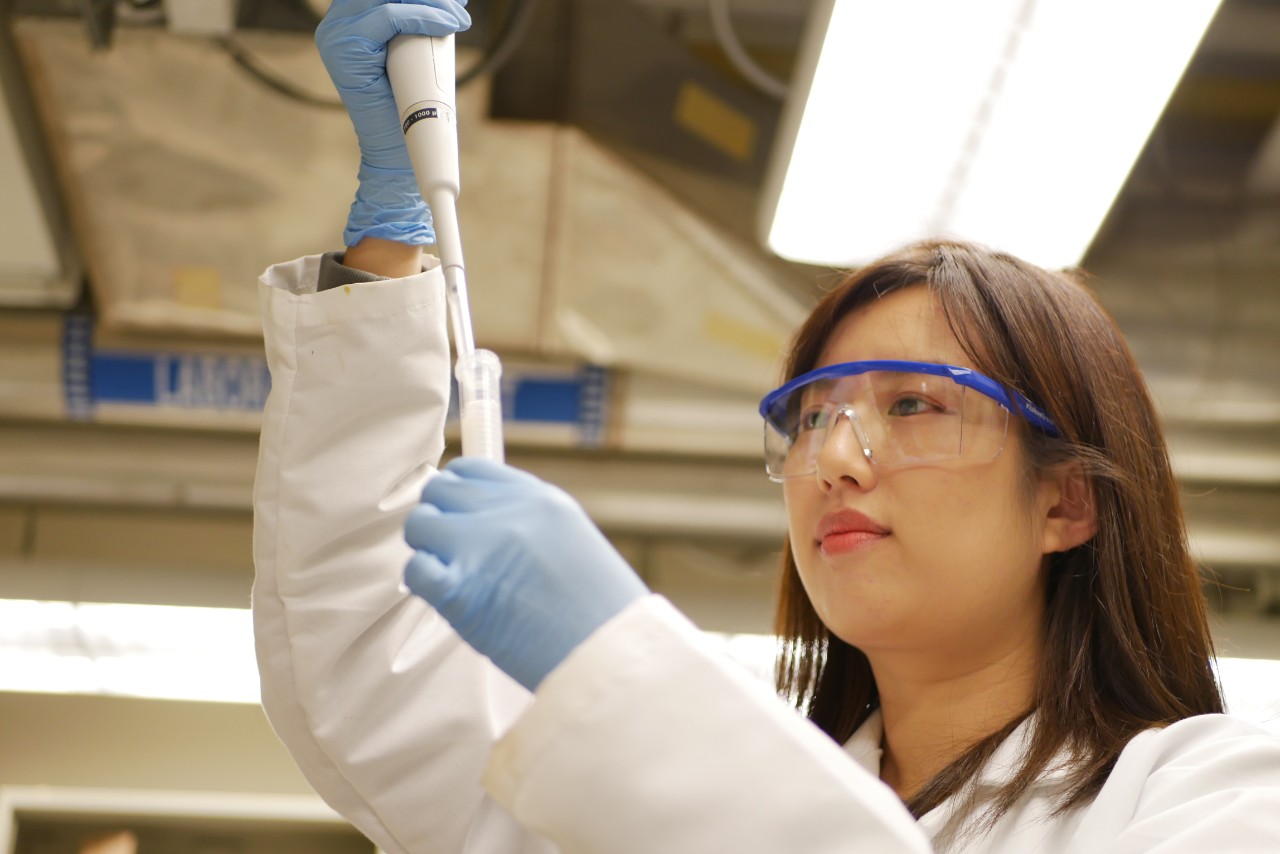
UC students publish frontier research on membranes for desalination
Water is the cornerstone of life on Earth. Yet nearly 40 percent of the world’s population faces water scarcity, according to a 2017 UNESCO report. Increased industrial activities put pressure on these limited water resources by discharging damaging, highly concentrated brine into the environment.
To mitigate the growing problems of brine waste, many researchers turn to membrane desalination to separate concentrated brines into freshwater and solid salts. But reaching “zero liquid discharge,” a state in which dissolved salts crystallize and precipitate in a recycled process, requires effective and affordable desalination technologies that don’t yet exist.
Student researchers at the University of Cincinnati recently published research in Science Advances that addresses this salty problem. They propose using ion-sieving zeolite membranes to achieve this zero liquid discharge.

UC Ph.D. candidate Zishu Cao transfers zeolite nanosheets. Photo/Corrie Stookey/CEAS Marketing
Desalination for separation
Many industries produce concentrated brine wastes. It can come from removing the salt from seawater to produce freshwater in desalination plants. But practices such as oil and gas drilling (fracking), as well as desulfurization in fossil fuel-based power plants create brine wastes as well.
Desalination can convert high-salinity brine into less damaging liquids for safe release. Separating the salt and liquid completely is the ideal solution. Besides reducing environmental damages, the process can produce solid-state byproducts with additional benefits such as use in construction materials and rare-earth material extraction.

UC Ph.D. candidate Zishu Cao tests membrane permeation on a computer. Photo/Corrie Stookey/CEAS Marketing
For the project, the UC team used a desalination method commonly called pervaporation or membrane distillation, which combines thermal and membrane desalination processes.
“You eventually recover all the salt in its solid state through an envisioned pervaporation and crystallization approach,” said UC professor Junhang Dong, Ph.D., advisor of the student authors of the paper.
Ultimately, the UC researchers hoped to reach zero liquid discharge while creating a membrane that withstands the harsh conditions of pervaporation desalination. To reach this goal, they used a versatile material called zeolite.
Crystal-clear water
Because of its crystalline structure, zeolite has tremendous potential as a membrane for separating water molecules from salt molecules. Each of zeolite’s pores is exactly the same size, which bodes well for water and dissolved ion separation.
Metal ions, like those that make up salt, are positively charged. These positively charged ions attract water molecules to form a hydration shell – in this case, saltwater. The hydrated metal ions are far bigger than the water molecules, which are less than 0.3 nanometers in kinetic diameter.
“The sub-nanometer scale pores can separate molecules effectively and efficiently by discriminating by their size,” Dong said. “In the past decade, our group demonstrated that zeolites are also ‘ionic sieves’ that can achieve ion-ion or ion-water separation by similar size-exclusion mechanisms.”
But zeolite membranes are not without flaws. Zeolite’s crystalline structure is ideal for creating concise pore sizes, but this structure is also the membrane’s greatest weakness.

Zeolite nanosheets are stored in test tubes in the lab. Photo/Corrie Stookey/CEAS Marketing
Conventional zeolite membranes form as block-shaped crystals, which resemble a wall of bricks, Dong says. These blocks are randomly piled, containing microdefects between the crystals that allow big hydrated ions to leak through.
Chemical engineering Ph.D. candidate Zishu Cao, one of the graduate students on the project, solved this problem by synthesizing a new type of membrane that is laminated with highly hydrophilic zeolite nanosheets.
The zeolite membrane solution
Researchers at the University of Minnesota first successfully synthesized two-dimensional zeolite nanosheets. A big problem with applying these sheets to desalination membranes, however, is zeolite’s hydrophobic properties.
“The surface chemistry of those membranes is not right for desalination,” Dong said. “To make this kind of structure with the desirable ionic and hydrophilic surface is not easy. It requires the addition of alumina into the silica framework of the crystal, and that makes it very hard to control its growth in preferential orientations.”
That’s where Cao’s work came in. She developed an innovative way to produce the nanosheets with an aluminum-containing crystal surface. This surface enhanced the transfer of water molecules while still rejecting the dissolved salts.

UC Ph.D. candidate Zishu Cao displays zeolite nanosheet-coated membranes. Photo/Corrie Stookey/CEAS Marketing
The UC team was the first to successfully demonstrate these aluminum-containing zeolite nanosheet-laminated thin membranes work in the desalination process. Cao and her teammates found that this zeolite membrane could successfully separate water from brine composed of up to 24 percent salt weight – an extremely high amount of salt, even for brine.
“Water problems and pollution treatment problems are arising all over the world,” Cao said. “This separation work is more energy-efficient compared to other technologies.”
Properly reusing or disposing of concentrated brine is one of the world’s greatest challenges. If applied commercially, UC’s zeolite membrane can have tremendous implications – industries may be finally be able to achieve zero liquid discharge from even the saltiest brine.
Featured image at top: UC Ph.D. candidate Zishu Cao examines a solution of zeolite nanosheets. Photo/Corrie Stookey/CEAS Marketing
Find your path
Interested in encouraging others as you find your path to academic success? If so, apply to UC as an undergrad or graduate inspirational Bearcat. As part of UC's Next Lives Here strategic direction, UC's students makes positive and real-world impact.
Related Stories
Study finds police officers face higher long-term health risks
January 2, 2026
J.C. Barnes, a University of Cincinnati professor, is interviewed by Spectrum News about new research showing that the physical and psychological demands of law enforcement can contribute to earlier deaths.
Challenges for veterans in the workforce
December 22, 2025
A new research review examines how veterans and their families impact the economy.
UC student breaks world record in competitive speedcubing
December 19, 2025
UC computer science student Sujan Feist set a new world record in speedcubing at competition this month in Coshocton, Ohio. Feist is the reigning world champion in the 2x2 division.
